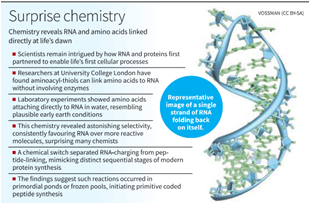

8th September 2025 (12 Topics)
Context:
A new study in Nature has demonstrated that aminoacyl-thiols can link amino acids to RNA without enzymes, providing insights into the origins of protein synthesis on early Earth.
RNA–Protein Puzzle:
- Modern cells use ribosomes and enzymes (proteins) to link amino acids to RNA, creating a chicken-and-egg problem in explaining the origins of life.
New Finding:
- Researchers discovered that aminoacyl-thiols can attach amino acids to RNA in plain water, without enzymes, under conditions that may have existed on early Earth.

Selectivity:
- Despite other reactive molecules being present, aminoacyl-thiols showed strong selectivity for RNA, mirroring processes seen in life today.
Chemical Switch:
- Thioesters help amino acids attach to RNA, while their conversion to thioacidsfavours peptide bond formation — separating the two modern steps of protein synthesis.
Prebiotic Chemistry:
- Aminoacyl-thiols could have been formed from simple precursors like nitriles and thiols in frozen pools, making this pathway plausible under natural early-Earth conditions.
Significance:
- This finding provides a realistic model for how RNA and amino acids may have directly interacted, bridging the gap between the RNA world hypothesis and the origin of protein translation.
|
RNA Structure of RNA
Types of RNA and Functions
|
More Articles


